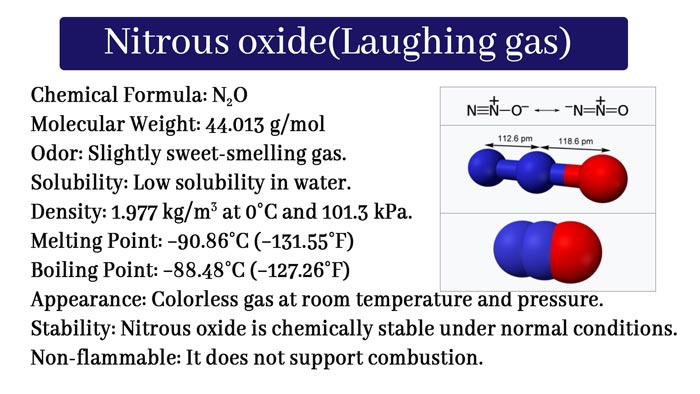- Sodium nitrite – NaNO2
- Copper sulfate – CuSO4
- Potassium permanganate – KMnO₄
- Ferric chloride – FeCl3
- Stannic chloride – SnCl₄
- Ammonia nitrate – NH4NO3
- Ammonia sulfate – (NH₄)₂SO₄
- Ferrous sulfate – FeSO4
- potassium hypochlorite – KClO
Priestley first made nitrous oxide gas in 1772 and Devi studied its properties. Smelling this gas causes laughter. For this reason, it is also called laughing gas.

Preparation:
Oxidation of hydroxylamine
nitrous oxide is obtained by oxidizing hydroxylamine salts with Sodium nitrite, copper sulfate, potassium permanganate or ferric chloride.
NH2OH.HCl + NaNO2 → NaCl + 2H2O + N2O
Reduction of nitric acid
reduction of HNO3 by stannic chloride (SnCl₄) and HCl gives nitrous oxidation.
4SnCl2 + 8HCl + 2HNO3 → 4SnCl4 + 5H2O + N2O
Dilute HNO3
when cold and the molecule HNO3 reacts with Zn, N2O is obtained.
4Zn + 10HNO3 → 4Zn(NO3)2 + 5H2O + N2O
Heating ammonia nitrate
Nitrous oxide is obtained by heating ammonia nitrate. On heating the ammonia nitrate alone, it melts at 1650C, starts to decompose at 1850C and starts exploding at 2400C. In the laboratory, nitrous oxide gas was first created by heating a mixture of ammonia sulfate and ammonia nitrate. The ammonia nitrate obtained from the mixture does not explode and Nitrous oxide gas is obtained.
(NH₄)₂SO₄ + 2NaNO3 → Na2SO4 + 2NH4NO3
NH4NO3 → N2O + 2H2O
Ammonia chloride and ammonia nitrate doing the same reactions:
NH₄Cl + NaNO3 → NaCl + NH4NO3
NH4NO3 → N2O + 2H2O
Laboratory method:
In the laboratory, the flask is heated by mixing a mixture of sodium nitrate and ammonia sulfate. The obtained nitrous oxide gas is affected by KOH, FeSO4 and concentrated sulfuric acid. Which removes impurities of chlorine, nitric oxide and ammonia respectively. N2O collects gas in hot water. Because it is soluble in cold water.

2KOH + Cl2 → KCl + KClO + H2O
2NaOH + Cl2 → NaCl + NaClO + H2O
FeSO4 + NO → FeSO4.NO
2NH3 + H2SO4 → (NH4)2SO4
Physical Properties:
This colorless sweet taste has gas. It is a fusion of water and alcohol. Its smell causes laughter. The smell in excess makes the man unconscious. And can also die of the throat.
Chemical Properties:
It has no effect on litmus. Hence it is indifferent.
On heating, it gives nitrogen and oxygen.
2N2O → 2N2 + O2
It gives oxygen on heating. Therefore, it helps in burning things like oxygen.
S + 2N2O → 2N2 + SO2
C + 2N2O → 2N2 + CO2
2P + 5N2O → 5N2 + P2O5
It dissipates when flowing over hot copper.
Cu + N2O → N2 + CuO
Use of N2O
Nitrous Oxide uses for especially in surgery and dentistry.
Structure:
The molecular formula of Nitrous Oxide is N2O and the structure is like this:
N ≡ N → O
The nitrogen atoms in nitrous oxide are sp hybridized and it is a linear molecule. Nitrous oxide is a polar co-ordinate molecule and its two-pole base must be higher, in fact, its double pole base is very useful. For this reason, it is assumed that it is a resonant hybrid of the following two structures.
